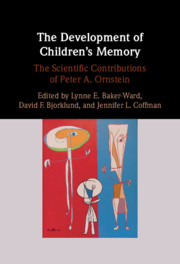Book contents
- The Development of Children’s Memory
- The Development of Children’s Memory
- Copyright page
- Dedication
- Contents
- Figures
- Tables
- Contributors
- Part I Backdrop
- Part II Children’s Memory Strategies
- Chapter 4 Overview
- Chapter 5 Strategies and Self-Derivation
- Chapter 6 Commentary
- Part III Children’s Event Memory
- Part IV Family Socialization of Memory
- Part V Classroom Socialization of Memory
- Part VI Perspective
- References
- Index
Chapter 4 - Overview
Deliberate Remembering in Children
from Part II - Children’s Memory Strategies
Published online by Cambridge University Press: 28 May 2021
- The Development of Children’s Memory
- The Development of Children’s Memory
- Copyright page
- Dedication
- Contents
- Figures
- Tables
- Contributors
- Part I Backdrop
- Part II Children’s Memory Strategies
- Chapter 4 Overview
- Chapter 5 Strategies and Self-Derivation
- Chapter 6 Commentary
- Part III Children’s Event Memory
- Part IV Family Socialization of Memory
- Part V Classroom Socialization of Memory
- Part VI Perspective
- References
- Index
Summary
Through the lens of Peter Ornstein’s work, this chapter traces the history of research on the development of deliberate memory. With particular emphasis on two mnemonic strategies, rehearsal and organization, we describe the methodological tools and research designs that have provided insight into the universal and individual patterns of development. Considerations are given to contextual factors, such as task conditions and instructions, types of materials to be remembered, and capacity demands, as well as to the individual factors, such as knowledge base, metamemory, age, and experience that influence the likelihood that a child will use strategies effectively in the service of memory. We conclude with an overview of the ways in which longitudinal research has provided greater insight into how intentional memory develops.
Keywords
- Type
- Chapter
- Information
- The Development of Children's MemoryThe Scientific Contributions of Peter A. Ornstein, pp. 45 - 61Publisher: Cambridge University PressPrint publication year: 2021

